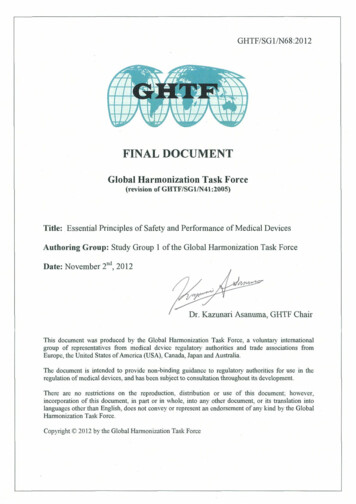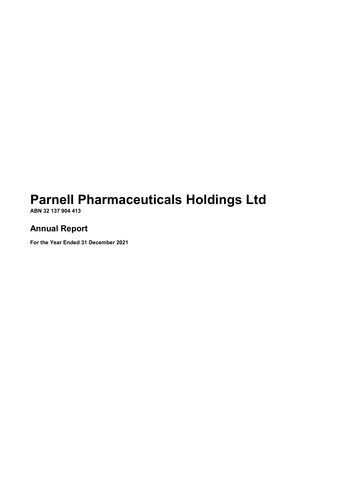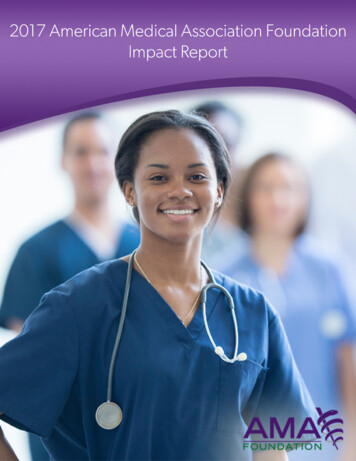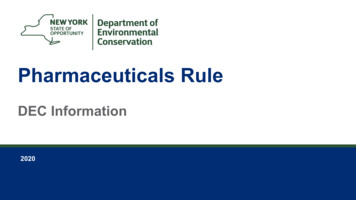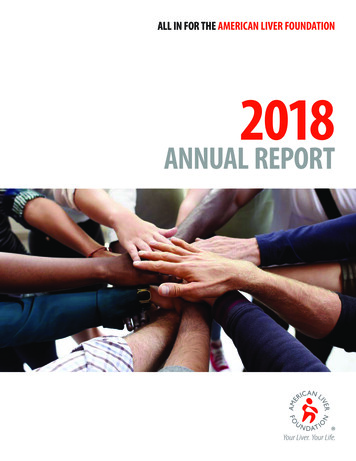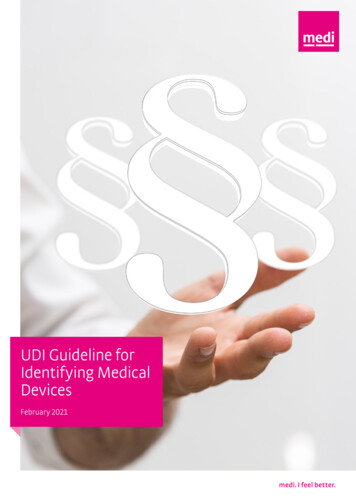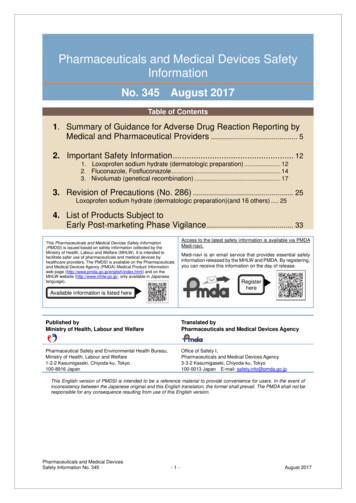
Transcription
Pharmaceuticals and Medical Devices SafetyInformationNo. 345August 2017Table of Contents1. Summary of Guidance for Adverse Drug Reaction Reporting byMedical and Pharmaceutical Providers . 52. Important Safety Information . 121. Loxoprofen sodium hydrate (dermatologic preparation) . 122. Fluconazole, Fosfluconazole . 143. Nivolumab (genetical recombination) . 173. Revision of Precautions (No. 286) . 25Loxoprofen sodium hydrate (dermatologic preparation)(and 16 others) . 254. List of Products Subject toEarly Post-marketing Phase Vigilance . 33This Pharmaceuticals and Medical Devices Safety Information(PMDSI) is issued based on safety information collected by theMinistry of Health, Labour and Welfare (MHLW). It is intended tofacilitate safer use of pharmaceuticals and medical devices byhealthcare providers. The PMDSI is available on the Pharmaceuticalsand Medical Devices Agency (PMDA) Medical Product Informationweb page (http://www.pmda.go.jp/english/index.html) and on theMHLW website (http://www.mhlw.go.jp/, only available in Japaneselanguage).Access to the latest safety information is available via PMDAMedi-navi.Medi-navi is an email service that provides essential safetyinformation released by the MHLW and PMDA. By registering,you can receive this information on the day of release.RegisterhereAvailable information is listed herePublished byMinistry of Health, Labour and WelfareTranslated byPharmaceuticals and Medical Devices AgencyPharmaceutical Safety and Environmental Health Bureau,Ministry of Health, Labour and Welfare1-2-2 Kasumigaseki, Chiyoda-ku, Tokyo100-8916 JapanOffice of Safety I,Pharmaceuticals and Medical Devices Agency3-3-2 Kasumigaseki, Chiyoda-ku, Tokyo100-0013 Japan E-mail: safety.info@pmda.go.jpThis English version of PMDSI is intended to be a reference material to provide convenience for users. In the event ofinconsistency between the Japanese original and this English translation, the former shall prevail. The PMDA shall not beresponsible for any consequence resulting from use of this English version.Pharmaceuticals and Medical DevicesSafety Information No. 345-1-August 2017
Pharmaceuticals and Medical Devices Safety InformationNo. 345August 2017Ministry of Health, Labour and Welfare & Pharmaceutical Safety and Environmental Health Bureau, Japan[ Outline of Information ]No.Subject1Summary of Guidancefor Adverse DrugReaction Reporting byMedical andPharmaceuticalProviders2Important SafetyInformationPC3Revision ofPrecautions (No. 286)PMeasuresOutline of InformationThis section will provide details on “the Summary ofGuidance for Adverse Drug Reaction Reporting by Medicaland Pharmaceutical Providers” based on the results of “theStudy of Promotion of Adverse Drug Reaction Reporting byLeveraging the Functions of In-hospitalPharmacy/Department of Pharmacy” performed in fiscal2016. The study focuses on the importance ofinterprofessional as well as interinstitutional collaborationsincluding out-of-hospital pharmacies in the latter in terms ofthe promotion of Adverse Drug Reaction reporting bymedical and pharmaceutical providers.Loxoprofen sodium hydrate (dermatologic preparation) , and2 otehres. Regarding the revision of the Precautions sectionof package inserts of drugs in accordance with theNotification dated July 4, 2017, the contents of importantrevisions and case summaries that served as the basis forthese revisions are provided in this section.PageLoxoprofen sodium hydrate (dermatologic preparation) (and16 others)List of ProductsList of products subject to Early Post-marketing PhaseSubject to Early PostVigilance as of June 30, 2017.marketing PhaseVigilanceP: Revision of Precautions, C: Case Reports45122533Reporting of safety information such as adverse reactions to the Minister of Health,Labour and Welfare is a duty of medical and pharmaceutical providers.If medical and pharmaceutical providers such as physicians, dentists, and pharmacists detect adversereactions, infections associated with drugs or medical devices, or medical device adverse events, it ismandatory for such providers to report them to the Minister of Health, Labour and Welfare directly or throughthe marketing authorization holder. As medical and pharmaceutical providers, drugstore and pharmacypersonnel are also required to report safety issues related to drugs and medical devices.Pharmaceuticals and Medical DevicesSafety Information No. 345-2-August 2017
AbbreviationsADRAIHALPALT (GPT)AMEDANAAST verse drug reactionAutoimmune hepatitisAlkaline phosphataseAlanine aminotransferase (Glutamate pyruvate transaminase)Japan Agency for Medical Research and DevelopmentAntinuclear antibodyAspartate aminotransferase (Glutamate oxaloacetate transaminase)Abdominal ultrasonographyv-raf murine sarcoma viral oncogene homolog B1Common bile ductCholecytohepatic duct (or Common hepatic duct)C-reactive proteinComputed tomographyDirect bilirubinDrug InformationDrug lymphocyte stimulation testEpstein-Barr virus immunoglobulin MEarly Post-marketing Phase VigilanceEndoscopic retrograde cholangiopancreatographyEndoscopic sphincterotomyEndoscopic ultrasonographyFiscal yearHepatitis AHepatitis B coreHepatitis B surfaceHepatitis B virus-Deoxyribonucleic acidHepatitis C virusHuman herpesvirus 6Health Policy BureauIntraductal ultrasoundImmunoglobulin EImmunoglobulin GLactate dehydrogenaseMarketing authorization holderMinistry of Health, Labour and WelfareMycophenolate mofetilMethylprednisolone sodium succinateMagnetic resonance cholangiopancreatographyNon-small cell lung cancerPharmaceutical Affairs BureauPerinuclear anti-neutrophil cytoplasmic antibodyProgressive diseasePharmaceuticals and Medical Devices AgencyPerformance statusPharmaceutical Safety and Environmental Health BureauPrednisoloneSegment 3 (left lateral inferior segment of hepatic lobe)Segment 4 (left medial segment of hepatic lobe)Pharmaceuticals and Medical DevicesSafety Information No. 345-3-August 2017
S7S8SDSOLT-BilTNMWBCγ-GTPSegment 7 (right posterior superior segment of hepatic lobe)Segment 8 (right anterior superior segment of hepatic lobe)Stable diseaseSpace-occupying lesionTotal bilirubinTumour-node-metastasisWhite blood cellsgamma-glutamyl transpeptidasePharmaceuticals and Medical DevicesSafety Information No. 345-4-August 2017
1Summary of Guidance for Adverse DrugReaction Reporting by Medical andPharmaceutical Providers1.IntroductionReporting of adverse drug reactions (ADRs) is managed under two systems: Companyreporting and medical institution reporting. Company reporting is the system where manufacturingauthorization holders (MAH) report ADRs to PMDA after collecting the information from medicalinstitutions/pharmacies, which is stipulated in the Law for Ensuring the Quality, Efficacy and Safetyof Drugs and Medical Devices at the Pharmaceutical and Medical Device Act Article 68-10(1).Medical institution reporting is the system where pharmaceutical providers such as physicians orpharmacists directly report to PMDA, stipulated in the Pharmaceutical and Medical Device ActArticle 68-10(2). Reports from companies have increased every year with approximately 51,000cases whereas reports from medical institutions have practically leveled off with approximately6,100 cases in fiscal 2015. (Figure 1)Changes in the number of drug ADR/infection reportsReports from companies have increased every year whereas reports from medical institutions have practicallyleveled off.The number of reports fromcompaniesChanges in the number of ADR/infection reportsThe number of reports from medicalinstitutions(Reference) Changes in the number of drug ADR reportsReports fromcompaniesReports frompharmaceutical providersFiscal 2012When the reporting from medical institutionsbecame compulsoryNumber of casesFiscal 2013When the reporting of infection casesbecame compulsoryThe monitor hospital system was abolished,and all medical institutions/pharmacies havebeen covered.Fiscal 2014Fiscal 2015Start of company reporting with administrativeguidance Start of monitor hospital systemIncrease in the number of monitorhospitalsWhen the reporting from companiesbecame compulsoryFiscal yearFigure 1Pharmaceuticals and Medical DevicesSafety Information No. 345-5-August 2017
On the other hand, in recent years, changes in the environment surrounding the safety of drugshave been observed, such as, diverse use of drugs produced by various MHA as driven by thepromotion of using generics, and multiple adverse effects not previously seen with single drugregimens, reflecting the aging society and multiple drug treatment such as multi-drug regimens forcancer treatment. .In “the Study of Promotion of Adverse Drug Reaction Reporting by Leveraging the Functions ofPharmacy/Department of Pharmacy” of the FY 2016 Health and Labour Administration PromotionResearch Project (the Health and Labour Sciences Special Research Project) (The studyrepresentative Professor Koichi Masuyama in School of Pharmacy, Tokyo University of Pharmacyand Life Science) integrated applicable cases in terms of promotion of ADR reporting by medicaland pharmaceutical providers and prepared “the Summary of Guidance for Adverse Drug ReactionReporting by Medical and Pharmaceutical Providers” (draft) with a focus on interprofessional withinan institution and interinstitutional collaboration involving out-of-hospital pharmacies (Figure 2). Youcan see the details of the Summary of Guidance below, which was issued dated July 10, 2017 witha partial change in the contents based on the discussion in the 2nd meeting of the Subcommitteefor Pharmaceuticals and Medical Devices Regulation of the Health Science Council of MHLW onJune 22, 2017.“The Study of Promotion of Adverse Drug Reaction Reporting by Leveraging theFunctions of Pharmacy/Department of Pharmacy”(Koichi Masuyama, the representative of the FY2016 Health and Labour Science Special Research Project) Recent changes of the environment surrounding drug safety.Backgrounds,issues Promotion of generic medicines - The fact that medicines distributed by various MAHs have been used. A multiple drug regimen characterized by anti-cancer treatment and for the elderly patients - Development of compositeADRs which would not be caused by a single agent. Specific measures need to be taken to collect ADR information and to prevent ADRs.Researchsummary Actual cases were integrated from the standpoint of promotion for ADR reporting from pharmaceutical providers. Sort out issues for implementation including the collaboration in an institution with cooperation of the Japan MedicalAssociation, the Japan Pharmaceutical Association and the Japanese Society of Hospital Pharmacists, and prepare theproposal for a better system to help discuss the future feasibility (a draft of the summary of guidance).* Research on Regulatory Science of Pharmaceuticals andMedical Devices of the AMED“Study on Strategies to Leverage ADR Information from Medicaland Pharmaceutical Providers to Enhance the Safety in DrugDevelopment”.CollaborationCollecting of case information on ADRReporting by collaboration of physicians,pharmacies and department ofpharmacyOrganizing tion of the Summary ofGuidance for Adverse DrugReaction Reporting by Medicaland Pharmaceutical Providers(draft) in the research group.Furtherinvestigations/discussion forverificationJapan Medical Association, JapanPharmaceutical Association, JapaneseSociety of Hospital Pharmacists, etc.Figure 2Pharmaceuticals and Medical DevicesSafety Information No. 345-6-August 2017
2.Summary of Guidance for Adverse Drug Reaction Reporting by Medicaland Pharmaceutical Providers(Administrative Notice Attachment by Safety Division, General AffairsPharmaceutical Safety and Environmental Health Bureau, MHLW dated July 10, 2017)Division,This summary of the guidance's purpose is to promote ADR reporting from medical institutions in"the Study of Promotion of Adverse Drug Reaction Reporting by Leveraging the Functions ofPharmacy/Department of Pharmacy" (Koichi Masuyama, the representative of the FY 2016 Healthand Labour Science Special Research Project). Therefore, the summary provides the expectedpoints to keep in mind when medical institutions - and pharmacies together in some cases - reportADRs with a suspected relation to prescription drugs so that the summary can help medicalinstitutions and other medical and pharmaceutical providers smoothly proceed with ADR reportingoperations.The Guidance will be enhanced by further investigating and examining the status and feasibilityof ADR reporting in various medical institutions.[Keys of Guidance] In recent years, the environment surrounding pharmaceutical safety has been changing.Generic prescription drugs (generic drugs) have been widespread and polypharmacy hascaused composite ADRs, which would not happen with a single drug, in many patientsincluding the elderly. Medical and Pharmaceutical providers are required to make efforts to prevent ADRs whichmay affect patients as much as they can. In addition, they need to collaborate between everyprofession in an institution and between institutions including out-of-hospital pharmacies inorder to find any first sign and alleviate the extent of ADRs which have occurred in patientsand to submit required ADR reporting.ADR reporting by medical institutions to the authority (PMDA and MHLW) is specified inArticle 68-10(2) (hereinafter, “Drugs and Medical Devices Safety Reporting System”) of thePharmaceutical and Medical Device Act. Medical institutions are required to take necessaryactions based on the significance.(Pharmaceutical and Medical Device Act Article 68-10(2)) Proprietors of pharmacies; proprietors ofhospitals or clinics for human beings or human-reared animals; or physicians, dentists, pharmacists,registered sales clerk, veterinarians and other medical professionals shall, in the case where they learn ofthe occurrence of any disease, disability or death suspected to be caused by the side effects from use ofthe pharmaceuticals, medical devices or regenerative medicine products, or the occurrence of anyinfectious disease suspected to be caused by the use of such items, and when it is found to be necessaryin order to prevent the occurrence or spread of hazards to public health and hygiene, report the same tothe Minister of Health, Labour and Welfare. (The reports are required to be submitted to PMDA asspecified in Pharmaceutical and Medical Device Act Article 68-13(3)). ADR reporting requires providing information which identifies multiple prescribed drugs andgenerics. Based on this, we outlined what medical institutions should do to promote directreporting to the authority (PMDA) by leveraging the Drugs and Medical Devices SafetyReporting System.[ADRs which require expedited reporting] MAHs report to the authority (PMDA) serious ADRs obtained from medical andpharmaceutical providers with the outcome of death, hospitalization or more serious within15 days or 30 days according to the seriousness assessment methods in the attachment of“Criteria for Seriousness Classification of ADRs, etc.” (PAB/SD Notification No. 80 issued bythe Director of Safety Division, Pharmaceutical Affairs Bureau (PAB), Ministry of Health andWelfare dated June 29, 1992) When medical and pharmaceutical providers report ADRsdirectly to the authority (PMDA) in the report forms specified by the Drugs and MedicalDevices Safety Reporting System, the following issues (*) should be considered. In addition,medical institutions should read the attachment of the relevant notice as well, as a referenceregarding the seriousness of cases (described later).Pharmaceuticals and Medical DevicesSafety Information No. 345-7-August 2017
(*) Refer to the following criteria regardless of the description in the package inserts even if the causalrelationship is not evident.[1] Fatal[2] Disabilities[3] Cases that may lead to fatalities[4] Cases that may lead to disabilities[5] Cases requiring hospitalization or prolonging duration of hospitalization for treatment at the hospital or clinic(excluding cases noted in [3] and [4])[6] Serious cases in accordance with cases noted in [1] to [5][7] Congenital disorders or abnormalities in later generations[8] Occurrence of infectious disease cases suspected to occur due to the use of relevant drugs, medical devices,regenerative medicine products, etc.[9] Of the malfunctions that occur due to the use of relevant medical devices, regenerative medicine products,etc., those with the risk of occurrence of cases, etc. noted in [1] to [7].[10] Besides the cases noted in [1] to [8], occurrence of cases which are not mild and could not be predictedbased on the package insert, etc.[11] Of the malfunctions that occur due to the use of relevant medical devices, regenerative medicines, etc., thosewith the risk of occurrence of cases noted in [10].Source: “Revisions in practices of reporting ADRs, infections, and malfunctions from medical institutions,etc. regarding drugs, medical devices, or regenerative medical products” (PSEHB Notification No. 03254 by the Director of the Pharmaceutical Safety and Environmental Health Bureau, MHLW, dated March25, 2016)[Handling of ADR information in medical institutions] Medical institutions should submit an ADR reporting when patients experience an ADR witha suspected relation to drugs which needs treatment, causes abnormal laboratory findings,or considerably affects their daily living. The authority (PMDA) horizontally evaluates the ADRreporting accumulation status in more than one medical institution and possible measuresfor proper use of drugs. Medical and Pharmaceutical providers, too, are expected tocontribute to the efforts. As for acute diseases, for example, some of the drugs may cause a certain number of ADRsin a relatively short period of time though the drugs will be effective according to the patient’scondition. In contrast, some chronic diseases might not yield an ADR until after a year or twoof continuous administration. Therefore medical institutions are expected to ascertain andreport ADRs according to patient's conditions when required. Medical institutions should alsoprovide necessary information to local clinics and pharmacies so that the patient can befollowed up when moving into home care. To submit ADR reports without delay (to the MAH and to the authority [PMDA and MHLW])and to help enhance healthcare and hygiene when cases with suspected ADRs reportableto the authority (PMDA) emerge, medical institutions should specify in advance and sharethe communication method, writing format, items to report between diagnosis and treatmentdepartments as well as between such departments and department of pharmacy within aninstitution. To collaborate with an appropriate department especially when a disease suspected tobe a serious ADR is not routinely treated by the prescribing department, medicalinstitutions should specify the in-house procedures and communication methods.When information on cases with suspected ADRs is shared between doctors of differentdepartments, the department of pharmacy, and other support divisions in an institution, inorder to ensure that all the cases for whom the same ADRs are suspected are managed afterthe initial occurrence, the medical institution should assign the manager to collect andmanage all information for regulatory reporting and the prior information of cases until theonset of the ADR in the institution (narratives, laboratory results, other descriptions in themedical record, compliance status, etc.). The responsibilities are expected to rest withmedical safety management offices, pharmaceutical safety management supervisors, DIoffice, department of pharmacy, etc. When a disease which results in hospitalization is suspected to be an ADR, it isdesirable to collaborate with the manager in charge of all the information and to obtaindetails including the patient's clinical course prior to hospitalization and medicationswhen considering subsequent reporting of the ADR expected. At the same time, allprescribed drug information should be obtained from the referral hospital, the primaryPharmaceuticals and Medical DevicesSafety Information No. 345-8-August 2017
pharmacy, the patient or their family. In addition, under the supervision of the manager above, all information on cases withsuspected ADRs within the institution should be collected, effectively reviewed andunderstood. Manuals are available for management of individual serious ADRs prepared by theacademic society of each field and issued by the MHLW, specifically to secure theopportunities for differential diagnosis and early detection of an ADR for other utoku index.html) (only available in Japaneselanguage) The relevant department of medical institutions need to closely communicate with thedepartment of pharmacy to identify prescribed/administered drugs, compliance and assessthe relationship between drugs and diseases suspected to be an ADR. It is especiallyimportant that physicians play a major role in deciding on the diagnosis and treatment. Theother roles like regulatory reporting should be shared by other people, such as pharmacistsin the department of pharmacy or DI office, or the pharmaceutical safety managementsupervisor. The institution should determine the role assignment in advance to avoid delayin necessary ADR reporting. For example, it is desirable to extract the relevant cases from the following hospitaldatabases and employ them when reporting to the authority (PMDA). Incident report database Cases of pharmaceutical intervention (database) DI office inquiries database Events for which a causal relationship with drugs are unclear or known ADRs should bereported to the MAHs or reporting to the authority (PMDA) in the report forms specified bythe Drugs and Medical Devices Safety Reporting System should be considered. Whenmultiple concomitant medications of a patient make it difficult to identify the single suspectdrug, or to report various MAHs of concomitant medications, etc., reporting to the authority(PMDA) in the report forms specified by the Drugs and Medical Devices Safety ReportingSystem may have priority. As a reference to consider the necessity of ADR reporting, the Attachment of “Criteria forSeriousness Classification of ADRs, etc.” (PAB/SD Notification No. 80 issued by the Directorof Safety Division, PAB, Ministry of Health and Welfare). ADRs of the liver, the kidneys, blood, hypersensitivity symptoms, the respiratory organs,the gastrointestinal organs, the circulatory organs, psycho-neurotic system, metabolicelectrolyte abnormality are divided into the following 3 grades based on theseriousness: Grade 1: Mild ADR Grade 2: Neither serious nor mild ADR Grade 3: ADR considered serious, which may be fatal or has the risk of causingpermanent dysfunction that hinders daily living depending on the patient’spredisposition or condition when pyrexia is observed.Take into account that cases classified into Grade 1 or 2 should be reported whenaccompanied with suspected ADRs that are not noted in the precautions, or when theyqualify as Grade 3. Take into account that a Grade 3 ADR should be reported within 15 to 30 days inconsideration of the public health and hygiene priority. This is not compulsory because theDrugs and Medical Devices Safety Reporting System does not set the deadline of reportingto the authority (PMDA) from the onset of the disease suspected to be an ADR. Initial ADR reports do not have to provide the details. The details may be subsequentlycovered in the follow-up reports. Follow the procedures below for a disease suspected to be an ADR in patients who receiveddrugs by out-of-hospital prescription.Pharmaceuticals and Medical DevicesSafety Information No. 345-9-August 2017
Specifically, take into account the fact that poor compliance and adverse events aremore common in the elderly receiving 6 or more drugs. Generics could have been dispensed to patients with an out-of-hospital prescription.Try to find the dispensing pharmacy to make an inquiry about the prescribed drug namefor identification purposes, as required. The name is also available in the medicationrecord book of the patient. When the pharmacy finds that the medical institution whichmade the inquiry did not issue the prescription, it should provide the information withthe prescribing institution. The institution should ask the pharmacy to provide the available information on thepatient’s compliance for the drugs dispensed in a different pharmacy or prescribed in adifferent medical institution. (If the ADR report is submitted by the medical institutionthat made the inquiry, the information should be distributed to other institutions via thepharmacy. See [ADR handling at pharmacy].) When any condition suspected to be an ADR in a patient is reported in a tracing reportfrom pharmacists, etc., the institution confirms the condition at the patient's visit orconsultation to determine the required treatment and whether the ADR is reportable.[ADR handling at pharmacy] To contribute to the safe drug supply and proper use of drugs, pharmacies are expected todetect any first signs of a possible ADR when dispensing drugs to patients, to recommendthat the patient see the prescribing physician, to provide information, or to discuss thereportability to the authority (PMDA) as required when the ADR is just suspected.Pharmacies should provide the relevant explanation and try to have patients understanddetails on major ADRs of the drugs dispensed, the time of onset and the duration for theADRs on the initial dispensing of high-risk drugs. Anti-cancer agents, coagulants, or other medications with high risks of fall in elderlypatients.Pay attention to signs for concerns about compliance and ADRs when checking andadjusting the unused drugs. Specifically, take into account the fact that poor compliance and adverse events aremore common in the elderly receiving 6 or more drugs. As the conditions which require attention, ask patients if they have experienced any of thefollowing events/situations since the drug administration was started.1) Dizziness, drowsiness, headache2) Outcomes of injuries etc. caused by the above symptom(s).3) Details of when an ADR was suspected and if the patient saw a physician for anyreasons other than the primary disorder and received treatment.4) Other conditions which may disrupt everyday life Dosage and administration of the drugs as well as surrounding details should beconfirmed if information such as if a patient's laboratory results of creatinine clearanceand the name of the disease together with the prescription were provided by the medicalinstitution the patient visited. When development of an ADR is suspected in a patient, give feedback on this to theprescribing medical institution in a tracing report or other methods. Comprehensivelyexamine a patient's concomitant medications including those dispensed by differentpharmacies, based on the medication record book of the patient. Consider reporting any cases with a suspected ADR which requires treatment or is notconsidered to be mild (refer to the above [ADRs which require expedited reporting]), incooperation with the prescribing medical institution to which a tracing report was sent, to theauthority (PMDA) in the report forms specified by the Drugs and Medical Devices SafetyReporting System, when required, even if the relationship with the drug is not necessarilyevident or the ADR is a known one. (See [Handling of ADR information in medicalinstitutions].)Pharmaceuticals and Medical DevicesSafety Information No. 345- 10 -August 2017
When a medical institution reports ADRs to the authority (PMDA), pharmacists shouldprovide the institution with the names of the drugs they dispensed and supplied(including those prescribed by other institutions - which should be given the details, too- ) and information available on the patient's compliance.When a pharmacy reports an ADR to the authority (PMDA) in a situation where allinformation is shared on a physician's diagnosis of ADRs, a patient's outcomes, andlaboratory results which are indicative of ADRs, the name of the prescribing medicalinstitution should also be present along with the name of pharmacy when submittingthe report.Note: The wording has been slightly amended and the contents have also been partially changedbased on the discussion in the 2nd meeting of the Subcommittee for Pharmaceuticals andMedical Devices Regulation of the Health Science Council of MHLW.3.ConclusionWe are exploring more practical contents for this summary of the guidance through furtherempirical research and evaluation in order to promote ADR reporting by medical andpharmaceutical providers in “the Study on Strategies to Leverage ADR Information from Medicaland Pharmaceutical Providers to Enhance the Safety in Drug Development”, Research onRegulatory Science of Pharmaceuticals and Medical Devices of the Japan Agency for MedicalResearch and Development (AMED).We hope medical and pharmaceutical providers will leverage this summary of the guidance forsmooth reporting from medical institutions or in collaboration with pharmacies and medicalinstitutions for ADRs with a suspected relation to prescription drugs.Pharmaceuticals and Medical DevicesSafety Information No. 345- 11 -August 2017
2Important Safety InformationRegarding the revision of the Pr
Medi-navi is an email service that provides essential safety information released by the MHLW and PMDA. By registering, you can receive this information on the day of release. Published by Ministry of Health, Labour and Welfare Translated by Pharmaceuticals and Medical Devices Agency Pharmaceutical Safety and Environmental Health Bureau,

